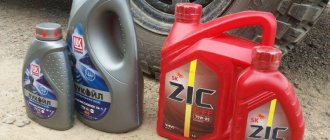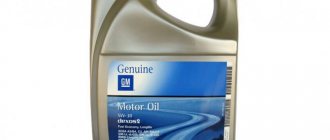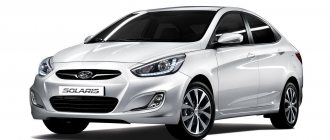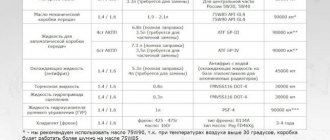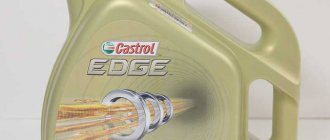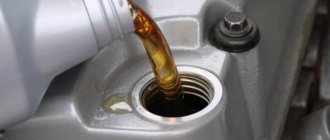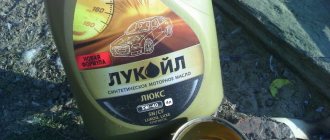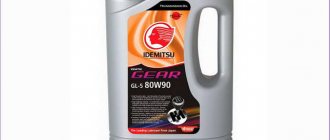Hyundai Accent is one of the most popular Korean cars of the mid-2000s. The car is respected by experienced and novice owners. At one time, the demand for this car was at a record high, and therefore it is not surprising that there are now a lot of such cars on the secondary market. But as you know, even a supported version of the Hyundai Accent will delight its owner with high quality workmanship and reliability. And yet, the question of the possibility of self-service for the Hyundai Accent remains relevant. Repairing and replacing consumables in this machine is quite feasible without professional knowledge and experience. In this article, we will consider one of the most pressing issues regarding the maintenance of this car - how to choose the right quality motor oil for the Hyundai Accent.
Each oil has its own parameters that must be followed when choosing a suitable lubricant. The parameters indicated on the product label must correspond to the parameters specified in the vehicle operating instructions. For example, the marking looks like 5W-20. This parameter corresponds to certain operating conditions. The value of this encoding will allow you to find out whether this oil is suitable for the Hyundai Accent engine.
- In the specified encoding, the number 5 characterizes the crankability and pumpability properties of the oil at the lowest temperatures. The lower this indicator, the lower the temperature the engine can start, or vice versa.
- Parameter 20, following the letter W, indicates the minimum and maximum viscosity of the lubricant, taking into account an engine temperature of 100 degrees, as well as the minimum viscosity at 150 degrees. The lower the viscosity rating, the better the fuel economy and the more engine power. However, it is important to note that low lubrication negatively affects engine reliability. Fortunately, manufacturers have long ago solved this drawback by using special additives.
- Viscosity parameters should be selected based on the ambient temperature in which the vehicle is operated. For example, for Russian conditions, the preferred option would be a lubricant with values of 0W, 5W and 10W. Based on this, for Hyundai Accent it is recommended to use a substance with parameters 5W-40, which are available in products of the following brands - Liqui Moly, Aral and Mannol.
Oil fill volume
The volume of lubricant poured is an equally important indicator not against the background of the above parameters. The fact is that an insufficiently optimal level of liquid filled will negatively affect the reliability of the engine and can cause so-called oil starvation. Overfilling the oil is also undesirable, as it can cause the oil seals and seals to be squeezed out, as well as the accumulation of oil components that do not have time to burn in the cylinder. As a result, these components turn into mud deposits that settle on surfaces.
Video
Many young car owners make a typical mistake - they violate the established rules for servicing a technical device. An unprofessional approach leads to undesirable consequences, especially when it comes to so-called independent intervention in the repair and diagnostic processes. It is not uncommon for service station technicians to correct errors. In order to provide methodological assistance, we will consider some issues related to service. So, Hyundai Accent, what oil to fill in the engine and how not to make a mistake when choosing.
Compliance with regulations
During operation of the Hyundai Accent model, you need to regularly monitor the level of engine oil in the unit. When it decreases, topping up is necessary. The lubricant should be completely changed within the prescribed period. It is advisable to trust this procedure exclusively to service technicians, who will advise whether it is worth replacing and which specific one to fill. There are usually several methods offered. The car owner makes his own choice. Experienced drivers make the replacement themselves.
In any situation, it should be taken into account that it is necessary to fill the engine oil after 6-7 thousand km. Manufacturers, however, recommend a mileage of 15 thousand, but certain factors must be taken into account when it already loses its characteristics.
- This is the seasonality of car operation and temperature changes
- Prevailing engine loads
- Management style
- Duration of being stuck in traffic jams
- Superior quality of roads
These factors may affect the timing of replacing lubricating fluids, regardless of mileage. If the unit is used particularly actively, it is advisable to change it every six months.
When replacing fluid on a Hyundai Accent, it is necessary to use products with a viscosity of 5W20-5W40.
The automaker insists on a similar order of searching for fluids. Each subsequent one is used as a result of the absence of the previous one. Car owners often complain that finding a branded product can be quite difficult, but then you should keep in mind that the golden mean will always help out: 5W30.
Experts on the forums admit that oil with similar indicators works great in Russian conditions.
The driving style of the car model influences the choice of fluid. A measured ride requires the use of Leichtauf Special with anti-friction properties. This oil prevents oxidation and saves fuel.
Gambling driving is associated with the addition of an effective additive, including molybdenum and a ceramic component. The unit is provided with high-quality protection under heavy loads. The automaker recommends motor oils from the brands Aral, Mannol, and others. Such lubricants are more suitable for modern models of units. Lubricating fluids of the above brands increase the oxidation resistance of the fluid base, have a longer service life, and save fuel.
The use of recommended motor oils does not violate special standards established by the automaker. A large assortment of motor oils indicates an understanding of the problems of car owners. Concern for comfort is manifested in the car owner’s choice of the necessary motor oil. The main thing is that the choice is based on knowledge of the needs.
Many young car owners make a typical mistake - they violate the established rules for servicing a technical device. An unprofessional approach leads to undesirable consequences, especially when it comes to so-called independent intervention in the repair and diagnostic processes. It is not uncommon for service station technicians to correct errors. In order to provide methodological assistance, we will consider some issues related to service. So, Hyundai Accent, what oil to fill in the engine and how not to make a mistake when choosing.
Choosing oil for the Hyundai Accent engine
There are many types of lubricants on the market, but not all of them are suitable for every technical product. When making an independent purchase, you must follow the recommendations in the vehicle’s operating instructions. For each car, the manufacturer clearly indicates the acceptable oil option.
Despite this, the instructions are not a dogma; they are advisory in nature. No one prohibits the use of other products or parts, the main thing is not to harm them.
For reference: three types of petroleum products have been developed for technical means: mineral; semi-synthetic; synthetic.
Depending on the brand and technical characteristics, one or another oil is filled into the engine. But, with one caveat, it is strictly forbidden to downgrade the lubricant class. For example: the manufacturer indicated that no lower than a semi-synthetic base is needed, mineral is not advisable. Of course, in emergency situations, you can pour it in, but do not mix it. This is the exception rather than the rule.
What kind of oil to pour into the Hyundai Accent engine
The Korean manufacturer directly indicates a semi-synthetic base with the index 10W40, 10W-30, 10W-50. These are considered to be all-season oils. There are so-called “winter” ones, especially for critical negative temperatures SAE 0W, 5W, 10W, 15W, 20W.
At the same time, the manufacturer allows the filling of a synthetic base with higher indices and classifiers. There is no mention of mineral oil, thereby implying that it is not recommended.
The third point is the brand of lubricant. This is the most difficult question of all for the reason that there are quite a lot of counterfeit products, it is difficult to distinguish the original from a high-quality fake. Buy oil at your own risk. Of course, preference is given to Mobile, Shell, Liquid Moly.
Which brand the owner should choose is a purely individual matter. If difficulties arise, you can always get qualified help from sales consultants. Try it and you will succeed. Now you know exactly what needs to be poured into the Hyundai Accent engine.
TOP 5 best oils for Hyundai Accent
This is my personal choice based on experience and analysis of information on the Internet. It is for informational purposes only and is not a call to purchase. The rating was not paid for by anyone, I do not cooperate with anyone here.
Source
| Gasoline API | Diesel API | Type | Recommended Manufacturers | ||||
| 2015 | 10W-40 10W-50 15W-40 5W-40
| S.M. | CI-4 | synthetics, semi-synthetics | SHELL, Castrol, Mobil, Xado, ZIC, Lukoil, Valvoline, GT-Oil | ||
| 2016 | 10W-50 15W-40 5W-40
| SN | C.J. | synthetics | Mobil, Castrol, SHELL, Xado, Valvoline, Lukoil, ZIC, GT-Oil | ||
| 2017 | 10W-50 15W-40 15W-50
| SN | C.J. | synthetics | Castrol, SHELL, Mobil, Xado, ZIC | ||
| 2018 | 10W-50 15W-40 15W-50
| SN | CJ-4 | only synthetics | SHELL, Mobil, Castrol, Xado | ||
| 2019 | 5W-50 10W-50
| SN | CJ-4 | only synthetics | SHELL, Castrol, Mobil | ||
| 2020 | 5W-50 10W-60
| SN | CJ-4 | only synthetics | SHELL, Castrol, Mobil |
Reviews from car owners
- Kirill, 32 years old, owner of a Hyundai Accent. I bought a car two years ago at an official car dealership. I am completely and completely satisfied with the model, no complaints. In a densely populated metropolis it consumes a minimal amount of fuel. He made his own adjustments: the manufacturer wrote that it is recommended to fill in oils of the semi-synthetic class, no lower. Having previously received the approval of the service station masters, I fill in the synthetic base from Mobile. I recommend;
- Vladimir, 44 years old, personal driver, Hyundai Accent car. Due to my profession, I deal with cars every day. My boss has it from scratch, under warranty, not even a year has passed. I visited the service station twice for a routine inspection, there were no comments. They indicated that the condition of the car was like new. I refill high-quality oils from Shell on a semi-synthetic basis;
- Mikhail, 27 years old, owner of a Hyundai Accent. Despite the fact that the car is already 7 years old, everyone can envy its like-new condition. This is thanks to care and timely maintenance. I only fill with high-quality fuel, good semi-synthetic oils, as prescribed by the manufacturer from Shell. Everyone is happy. I recommend;
- Victor, 39 years old, owner of a new Hyundai Accent. I bought a car a month ago from a car dealership. I have already driven 4500 km and passed the first maintenance. There are no complaints, the car works properly. I only fill with high-quality oils and fuel. The manufacturer indicated semi-synthetic, I adhere to the standards, I bought Shell. Recently, friends advised me to switch to a synthetic base from Mobile, I’m still thinking about it.
To prevent wear and ensure normal operation of a car engine, operating oil must be used in the engine. If a consumable material loses its properties, it will not be able to lubricate the rubbing parts and components of the power unit. In this article we will talk about what oil to pour into the Accent and what the process of replacing the fluid with your own hands is.
[Hide]
Description G4EC
Serially installed on Hyundai since 1999. It was installed on countless variations of the Accent, but since 2003 it was installed only on versions for markets in developing countries. The manufacturer guarantees trouble-free operation of the internal combustion engine for 100 thousand km or 7 years of active operation.
Engine features are given below.
- The gasoline “four” has two camshafts located on top of the cylinder head. One of them controls the operation of the intake valves, the second controls the exhaust valves.
- The motor is fixed on several flexible cushions under the hood of the car. Half of the supports are attached to the gearbox, the rest - directly to the engine.
- The crankshaft is five-bearing, made of durable cast iron. 8 counterweights are molded together with the shaft. They reliably balance the element and eliminate vibrations during the working stroke. In addition, it is the counterweights that center the crankshaft and help better tune the engine during repairs.
- There is no need to adjust the valves on this engine. Hydraulic compensators are responsible for this function, everything happens automatically.
- The oil system holds 3.3 liters of oil. The manufacturer recommends pouring 10W-30, and owners recommend using Mannol synthetic 5W-30. As for gasoline, you can fill it with regular 92, but without unnecessary additives.
- Engine power is 101 hp. With.
The usual layout of parts working together with the engine.
- On the right side of the G4EC, elements such as intake valves, power steering, and an air conditioning compressor found their place.
- On the reverse side of the internal combustion engine there is a thermostat and ignition coils.
- An oil indicator, various pressure meters, a generator, and an oil filter are installed on the front.
- At the rear there is a throttle assembly, an injection rail with injectors and a starter.
- The upper compartment is closed with a plastic cover with wells in which the spark plugs are located.
The engine cylinder block is made of cast iron and includes cylinders, oil channels, and a cooling device. 5 main bearing supports, equipped with removable covers, are firmly attached to the bottom of the BC.
The oil filter on this internal combustion engine deserves special attention. It is full-flow, equipped with a real ventilation duct system. It actively participates in oil distillation: first, the pump pumps out lubricant from the crankcase, from where the liquid goes through the filter into the feed line. Then the oil enters the cylinder head and onto the camshafts. It goes to hydraulic valve compensators and bearings. At the end, the lubricant, passing through the drainage holes, descends again to the pan, thereby completing circulation through the system.
It is noteworthy that the most loaded parts of the G4EC engine are lubricated with oil by splashing under pressure. The remaining parts of the motor are coated with grease by gravity.
| Hyundai Turbo SYN Gasoline 5W-30 Article –(05100-00441) 4l | 5W-30 MOTUL 8100 X-clean Article 106377 5l 10W-40 Lukoil Genesis Universal | 10W-40 Liqui Moly Optimal Article 3930 4l |
| Engine capacity, cc | 1495 | |
| Maximum power, hp | 102 | |
| Maximum torque, N*m (kg*m) at rpm. | 133 (14) / 3000; 134 (14) / 4700 | |
| Fuel used | Gasoline AI-92 | |
| Fuel consumption, l/100 km; city/highway/mix. | 9.9 liters/6.1 liters/7.5 liters | |
| engine's type | In-line, 4-cylinder | |
| Injection system | distributed fuel injection | |
| Cylinder diameter, mm | 75.5 | |
| Number of valves per cylinder | 4 | |
| Compression ratio | 10 | |
| Piston stroke, mm | 83.5 | |
| cylinder head | aluminum 16v | |
| Cylinder block | cast iron R4 | |
| Hydraulic compensators | in stock | |
| Timing drive | belt | |
| What kind of oil to pour | 3.3 liters 10W-30 | |
| Environmental class | EURO 3/4 | |
| Approximate resource | 250,000 km | |
| What cars was it installed on? | Accent LC 1999 - 2012 |
How often does it need to be replaced?
In Hyundai Accent TagAZ 2004, 2006, 2007, 2008, 2013 and other years of production, according to the recommendations of the manufacturer, the lubricant must be changed after a mileage of 12-15 thousand kilometers. In fact, domestic experts recommend replacing the fluid in a car engine at least every 6-10 thousand km.
There are a number of factors as a result of which the liquid loses its performance characteristics:
- seasonality of machine use, taking into account temperature changes at different times of the year;
- driving style - aggressive or gentle;
- the volume of loads placed on the engine;
- duration of operation of the power unit in traffic jams;
- quality of road surface;
- volume of the power unit;
- engine number, as well as its year of production.
These factors can reduce the service life of the motor fluid, regardless of the mileage of the car. If the power unit operates under intense conditions, then experts advise changing the oil every six months
.
What oil is better to fill?
If you don’t know what kind of motor oil to put into the engine of a used Hyundai Accent, you need to understand the products recommended by the manufacturer. Any oil corresponding to the viscosity characteristics 5W20, 5W30, 5W40 is suitable for operation. The vehicle manufacturer recommends this order of search for lubricants. If it is not possible to find a product with a viscosity grade of 5W20, you can use 5W30 fluid.
An important factor when selecting a product is the style of movement. If you prefer a more relaxed driving style, experts recommend filling Accent 8 or 16 valves with Leichtauf Special LL SAE 5w-30 lubricant. This oil has high anti-friction characteristics. Under harsh operating conditions, the lubricant prevents the formation of oxidation in the system and helps save fuel. If you prefer a more aggressive style of movement, then CeraTec additives can be added to the power unit. They are manufactured using molybdenum-based technologies using ceramic components. The motor is provided with reliable protection when operating in aggressive conditions.
The automobile manufacturer advises consumers to use Aral, Mannol and Liqui Moly oils. These products are optimally suited for use in modern engines. Lubricants enhance the oxidation resistance of base products and are characterized by an extended service life. With proper engine operation, fuel savings can be achieved. It doesn’t matter whether synthetics or semi-synthetics are used.
The Hyundai manufacturer allows the use in engines of fluids that meet the ACEA C3 viscosity class:
- Shell Helix Ultra;
- Aral SuperTronic LongLife 3;
- Elf Solaris;
- Longtime High Tech;
- Midland Crypto.
User Evgeniy Sagaydak spoke in detail in his video about the choice of motor fluid for the Accent internal combustion engine.
Selecting a filter element
The oil filter also belongs to the category of consumables; it also needs to be changed. According to the manufacturer's recommendations, it is best to use original filter devices. They allow you to effectively clean consumables from impurities and contaminants, as well as wear products of the power unit. If original filters are not available, analogues can be installed.
We are talking about brand devices:
- ALCO Filter;
- AMC Filter;
- Bosch;
- Ashika;
- Blue Print;
- Champion;
- Fiaam;
- Fram;
- Filtron.
Level control and required volume
It is important to know exactly how many liters need to be poured into the power unit. If the amount of lubricant is insufficient, this will lead to malfunctions in the operation of the machine’s motor. And the excess volume of liquid will cause the sealing elements and seals to be squeezed out. In addition, if there is an excess, the level of combustion of additives and lubricants in the internal combustion engine cylinders will increase. All unburned elements will eventually reduce the efficiency of the catalyst, settling on its internal surfaces. The exact volume poured into the motor is indicated in the technical manual for the machine. How much car owners pour into the internal combustion engine depends on the year of manufacture, as well as the modification of the vehicle. On average, 4.3 liters is enough to fill the engine.
The fluid level is checked on a cold engine. Open the hood of the car and find the diagnostic dipstick; it is installed in a special hole on the cylinder block. Take it out and wipe it with a rag, then put it back in and pull it out again. Ideally, the fluid level should be between the Min and Max marks.
Possible causes of oil consumption
What factors influence increased engine fluid consumption:
- Overfilling of lubricant. This causes increased fluid consumption. The crankcase ventilation system of the internal combustion engine will begin to squeeze out excess volume from the power unit.
- Leakage of lubricant from irregularities and areas damaged by corrosion.
- Constant operation of the vehicle at high speeds, especially during running-in of the power unit.
- Fluid viscosity class mismatch. If this parameter is too high, the combustion of the lubricant will occur more slowly.
- Accelerated wear of power unit components. Oil control valves fail, and gaps may appear on the valve sleeve and stems. Piston rings, etc. wear out.
The main reason for rapid consumption is usually the loss of liquid. The greater the number of pistons in the internal combustion engine, the faster the unit will consume oil.
According to experts, one overheating of a machine motor can lead to the unit starting to eat lubricant.
One of the biggest problems is leakage. Fluid can leave the lubrication system from under the valve cover, cylinder head gasket, filler neck seal, or drain hole. Often, lubricant leaks out from under the camshaft and crankshaft seals, oil filter or oil pan gasket. Leak locations can be determined by visual diagnostics. If it was not possible to identify the cause by eye, then most likely the engine is eating lubricant as a result of wear on the piston rings or valve stem seals.
Common faults
The most common problems that occur are:
- Interruptions and unstable operation at XX. At operating speeds, the engine loses power and consumes more fuel than before. As a rule, these signs indicate problems with the injector or fuel pump. Also not an exception are spark plugs that do not provide a spark well enough.
- Uncharacteristic exhaust noise at idle. The sounds are uneven, multi-toned, with small or large pauses of silence. Symptoms indicate clogged injectors and faulty spark plugs.
- Binge on butter. Occurs due to stuck piston rings.
- Strong vibrations. As a rule, this indicates wear on the engine mounts.
- Floating speed may be caused by a malfunction of the control unit. Reflashing the control unit will help.
Changing the lubricant yourself
You can replace consumables yourself, without involving specialists.
Tools and materials
What you will need to complete the task:
- fresh motor fluid;
- filter device;
- drain plug with o-ring;
- wrenches 17 and 19;
- special tool for removing the oil filter;
- set of star keys.
You can learn more about replacing consumables and filter devices from the video made by user Andrey Florida.
Stages of work
Changing the working fluid in the Hyundai Accent power unit is done as follows:
- Warm up the car engine. When the power unit reaches operating temperature, the viscosity characteristics of the lubricant decrease. The consumable material becomes more liquid, which allows you to drain it from the engine without any problems.
- Drive the Hyundai Accent into a garage with a pit or onto an overpass. Stop the engine and give it about 15 minutes to cool down.
- Reach under the car and locate the drain plug. Waste liquid will come out of it. Place a container under the plug into which the waste will be drained. This could be an old bucket, basin or cut-off bottle. If the car is equipped with a sump guard, it must be removed; to do this, unscrew all the bolts that secure it.
- Unscrew the drain plug and wait until all consumables have left the system.
- Assess the condition of the drained consumable fluid. If there is serious contamination and deposits, as well as wear products, it is recommended to flush the power unit. For cleaning you will need a special product. This oil can be purchased at any auto store. Tighten the drain plug and pour flushing agent through the filler neck, then start the engine and let it run. The time that the engine should run is indicated on the oil label. Drain the flushing agent from the lubrication system after cleaning.
- Install a new plug into the drain hole with a rubber seal.
- Before adding new fluid to the lubrication system, the filter device must be changed. The Hyundai Accent can use two types of parts - replaceable and non-sectional steel. Replacement filters are removed by unscrewing the screw located on the device body. When removing, it is recommended to visually inspect the replacement components. As for non-separable filters, they are unscrewed counterclockwise using a wrench. Remove the old part by unscrewing it counterclockwise. If problems arise during dismantling, use a special puller for removal. This device is sold in any store. If you don't have a tool, you can use a piece of a bicycle chain and wrap it around the filter housing. Alternatively, pierce the device with a screwdriver in a place closer to the bottom, away from the threads, so as not to damage the engine components. The tool will be used as a lever. Before installing a new filter, pour about 100-1500 grams of fresh oil into it and lubricate the rubber band near the threads. Install the filter device, but do not overtighten it.
- Unscrew the filler plug and pour fresh lubricant into the system. It is convenient to use a funnel to add liquid to the power unit. Fill in the required volume of consumables, regularly monitoring the fluid level in the lubrication system using a dipstick. After filling, start the car engine for a few minutes and let it idle. Stop the engine and check the lubricant level again. Add oil if necessary. Reinstall the engine oil pan protection.
The engine oil in the Hyundai Accent engine, in accordance with the routine maintenance schedule, should be changed every 15 thousand kilometers. However, if you use the car intensively, replacement should be carried out twice as often, i.e. after 7-8 thousand km. The process of changing the lubricant itself is not difficult even for a person who has never done this before, so it can be done at home.
Selecting oil
The type, type and amount of engine oil for Hyundai Accent depends on the engine and year of manufacture of the car. The table below shows the oils recommended by the car manufacturer.
| Engine | Engine capacity, cm cube | Year of issue | Engine oil type | Amount of oil, cm cube |
| G4EA | 1,3 | 1994 | Mineral 10w40 | 3,3 |
| 1995 | Semi-synthetic 10w40 | 3,3 | ||
| 1996 | Semi-synthetic 10w40 | 3,3 | ||
| 1997 | Semi-synthetic 10w40 | 3,3 | ||
| 1998 | Semi-synthetic 10w40 | 3,3 | ||
| 1999 | Semi-synthetic 10w40 | 3 | ||
| 2000 | Semi-synthetic 10w40 | 3 | ||
| 2001 | Semi-synthetic 10w40 | 3 | ||
| 2002 | Semi-synthetic 10w40 | 3 | ||
| 2003 | Semi-synthetic 10w40 | 3 | ||
| 2004 | Semi-synthetic 10w40 | 3,3 | ||
| 2005 | Semi-synthetic 10w40 | 3,3 | ||
| 2006 | Semi-synthetic 10w40 | 3,3 | ||
| G4EE | 1,4 | 2006 | Synthetic 5w30 | 3,3 |
| 2007 | Synthetic 5w30 | 3,3 | ||
| 2008 | Synthetic 5w30 | 3,3 | ||
| 2009 | Synthetic 5w30 | 3,3 | ||
| 2010 | Semi-synthetic 10w40 | 3,3 | ||
| G4EE | 1,5 | 1994 | Mineral 10w40 | 4,2 |
| 2003 | Mineral 10w40 | 4,2 | ||
| 2004 | Mineral 10w40 | 4,2 | ||
| 2005 | Mineral 10w40 | 4,2 | ||
| 2010 | Semi-synthetic (diesel) 10w40 | 4,2 | ||
| D4FA | 1,5 | 2006 | Synthetic 5w30 | 5,3 |
| 2007 | Synthetic 5w30 | 5,3 | ||
| 2008 | Synthetic 5w30 | 5,3 | ||
| 2009 | Synthetic 5w30 | 5,3 | ||
| G4FK | 1,5 | 1999 | Semi-synthetic 10w40 | 3,0 |
| 2000 | Semi-synthetic 10w40 | 3,0 | ||
| 2001 | Semi-synthetic 10w40 | 3,0 | ||
| 2002 | Semi-synthetic 10w40 | 3,0 | ||
| G4EK | 1,5 | 1995 | Semi-synthetic 10w40 | 3,3 |
| 1996 | Semi-synthetic 10w40 | 3,3 | ||
| 1997 | Semi-synthetic 10w40 | 3,3 | ||
| 1998 | Semi-synthetic 10w40 | 3,3 | ||
| G4ED | 1,6 | 2003 | Semi-synthetic 10w40 | 3,3 |
| 2004 | Semi-synthetic 10w40 | 3,3 | ||
| 2005 | Semi-synthetic 10w40 | 3,3 | ||
| 2006 | Semi-synthetic 10w40 | 3,3 |
As for the brand of oil, the choice is yours. Naturally, it is recommended to use proven lubricants from well-known manufacturers.
Information from official literature
Let's open the TagAZ brochure and see what the manufacturer recommends.
The following materials are suitable for 16-valve valves with a volume of 1.5 liters:
- viscosity : 10W-40, 5W-30 or 5W-40;
- ACEA quality: A3/B3 or A3/B4;
- Important! HTHS Viscosity: 3.5 mPas or more.
SAE viscosity grade is selected according to climate:
That's all. But this information is not enough for practice.
What do we pour (editorial emphasis)
Shell Helix Ultra 5W-40 (synthetic) - the price tag bites. But in the 5 years that we’ve had the Accent, we haven’t had any problems with the engine!
Filter and drain plug
When changing the oil, the oil filter and oil drain plug with sealing gasket must be changed. The table shows original filters and plugs, as well as their analogues from well-known manufacturers, indicating the catalog numbers of spare parts.
| Manufacturer | Part number according to the catalog |
| Oil filter | |
| Hyundai | B17003H |
| Bosch | 0 451 103 316 |
| Ashika | 1007703 |
| And | 40129003 |
| Japanese cars | B17003 |
| Besf1ts | FL1006 |
| Bosch | 0 451 103 316 |
| Chrysler | MZ690150 |
| Jakoparts | J1317003 |
| Js asakashi | C307J |
| Japanparts | FO703S |
| Mann | MW810 |
| Mando | MOF4459 |
| Mitsubishi | MZ690150 |
| Maxgear | 26-0272 |
| Nipparts | J1317003 |
| Motorparts | 15400-PR3-003 |
| Sakura | C1016 |
| Profit | 1540-0740 |
| Vic | C-307 |
| Toko cars | T1116003 |
| Drain plug | |
| Hyundai | 2151323001 |
| Ajusa | 18001100 |
| Elring | 726760 |
| Febi | 30181 |
| Kia | 21513-23001 |
| Mitsubishi | MD050317 |
| Mobis | MOB2151323001 |
| Onnuri | 21513-23001 |
| Pmc | P1Z-A052M |
Procedure for changing oil
1. Place the car on the inspection pit, having previously warmed up the engine to operating temperature. Hot oil drains much faster. Secure the vehicle by engaging the gear and parking brake.
2.Lift the hood and unscrew the filler cap. This way the pressure in the system will be equal to atmospheric pressure and the oil will flow out much more intensely.
3.Move to the inspection hole. First, you need to remove the engine protection (if there is one) to get to the oil pan.
4.The protection can be secured in different ways: on bolts around the perimeter or on canopies.
5. In the first case, you will have to unscrew all the bolts, in the second - only 2 (in the rear). Then the protection can simply be moved to the side so that it does not interfere with the work.
6.Removing the protection, you will see the oil pan and drain plug.
7.In fact, you need to unscrew this plug to drain the old oil. But be careful! You warmed up the engine, which is why the lubricant in it is hot. Unscrew the plug with a key (head) set to “17” very carefully so that the oil does not get on your hands. It is better to use a head with a long rod. Place a container under the plug in advance to collect waste.
8.Now let's move on to the oil filter. It is located on the back of the crankcase.
9.The filter can usually be unscrewed by grasping it with both hands and turning it counterclockwise. If it does not unscrew, use a special puller.
10.But if a puller could not be found, and the filter cannot be removed, you can try to unscrew it by wrapping it with an old belt, a medical tourniquet, or carefully pierce it with a large screwdriver, and then use it to turn it in the right direction.
11.Oil will also leak from under the filter, so make sure you have an appropriate container on hand.
12.When the oil has drained, screw a new plug into the oil pan.
14. Screw the filter onto the corresponding fitting. Don't overdo it by tightening it.
15. We proceed to pouring new oil. Take a watering can and place it in the filler neck.
16.Fill with oil so that a third of the required volume remains in the canister. Measure the oil level in the system using a dipstick. Next, fill in the lubricant in doses so as not to overfill.
17.When the oil is filled to the required level, tighten the filler cap, start the engine and let it run for a while. When the engine has cooled, recheck the oil level.
18.Upon completion of work, install the crankcase protection.
If you still have questions regarding the process of changing the oil in a Hyundai Accent engine, watch the thematic video
If the car owner visits the Hyundai Accent in a timely manner, this will significantly extend the life of the engine, protect against serious breakdowns and prevent high repair costs. It is important not only to carry out this procedure on time, but also to select the oil itself in accordance with the operating characteristics of the car and the requirements of the Korean automaker. You can do this kind of work yourself if the car is no longer under warranty. That’s why most car owners prefer not to seek help from a service station.
The engine oil in your Hyundai Accent should be changed regularly.
Replacement frequency
First, the driver must understand how often the Hyundai Accent is driven. If you rely only on the official factory manual, then there you will see figures of 10 - 15 thousand kilometers. But these are conditional indicators, since the real interval between oil changes is actually much shorter. This is due to the fact that the manual specifies parameters focused on almost ideal operating conditions, mild climate and high-quality roads. In Russia, the replacement interval becomes shorter, since the condition of the lubricant and its physical and chemical properties are influenced by the following factors:
- strong and sudden temperature changes between seasons;
- aggressive driving style;
- excessive regular load on the engine;
- use of towbar and trailer;
- long periods of idle time in traffic jams;
- poor quality of roads;
- use of low-quality fuel;
- speeding, etc.
Therefore, the actual interval between engine lubricant changes for the Hyundai Accent is about 6 - 7 thousand kilometers, or once a year. The car owner himself must monitor the condition and level of the oil, add it as necessary or change it completely. Some breakdowns or malfunctions can render the new oil unusable even after 500–1000 kilometers. Therefore, the driver is obliged to regularly monitor the serviceability of all components of the Accent. Experienced owners of Hyundai Accent cars advise, whenever possible and with very active use of the car, to change the lubricant in the engine every 6 months. This will allow the engine to work better and longer without serious problems and loss of engine life.
Major renovation
Rarely occurs before 100,000 miles. However, anything is possible, especially with gasoline and oil like we have in our country. There are known cases of overhauls on a G4EC engine that has driven only 10,000 km.
What do they do in this case?
- The cylinder head is opened.
- Check the honing to ensure there are no strong scuffs on the walls. If the internal combustion engine overheats, the gasket may become stuck.
- They test the condition of the head itself so that nothing goes wrong anywhere. The valves are checked for leaks and burnout. In most cases, a decision is made to replace the valve stem seals.
- Check the engine piston group. On a knocked engine, burst or cracked piston rings are not uncommon. On G4EC this happens more often with pots 2 and 4. The piston skirts also wear out, which is inevitable on the lightweight G4EC engine. On this one, the connecting rods are thin, without the proper margin of safety.
- The oil drain holes are checked to see if they are functioning or not. If yes, then the oil was poured on time, there is no danger here.
- The connecting rod bearings are inspected. Again, on a lightweight internal combustion engine there is more wear here. Along the axis of rotation, the connecting rod is aligned with the crankshaft journal. This provides protection for the connecting rod bearings. On the other hand, the presence of hydraulic compensators negatively affects the condition of thin-walled connecting rods.
- The valves are checked, if everything is normal, then a decision is made to carry out grinding. All valves are polished with a drill to a shine, but you should work carefully so as not to touch the chamfers. The valves themselves installed here are expensive - a piece costs 500 rubles. You can use any high-quality lapping paste, for example, Don Dil.
After this, the head is assembled. You can clean the combustion chamber with kerosene.
An interesting solution from professionals regarding connecting rods. It is recommended to rebuild the engine by installing connecting rods with a wide neck. This will make it possible to center the piston in the cylinder not as before, but at the expense of the neck, which is much more beneficial in terms of service life and extraneous noise.
Oil selection
In the operating manual for the Korean brand Hyundai Accent, the manufacturer recommends that they meet official requirements. The main focus of the Accent is on the viscosity of the engine oil. It is optimal that the replacement is carried out using oils that correspond to the following values:
- 5W20;
- 5W30;
- 5W40.
The manual indicates this order, so first look for 5W20, and if you cannot find such a composition, follow the list. The performance of the engine largely depends on what type of oil you choose.
Owners of cars modeled around 2005 and 2007 complain that it is difficult to find branded lubricant with a viscosity of 5W20. Therefore, you have to select something from alternative offers on the market. Although the practice of Russian car owners clearly demonstrates that oil with the 5W30 index is excellent for a Hyundai Accent car in our climate. With it, the car behaves confidently and does not suffer from temperature changes.
The manual contains a list of several well-known manufacturers of motor oils that the Korean company recommends for its Accent. These are the following brands:
- Aral;
- Mannol;
- Liqui Moly.
These lubricants are recommended for newer cars equipped with new power units. Such compositions increase oxidation resistance, have a long service life and help save fuel. Although the Accent cannot be called a car with high consumption, this is another small pleasant bonus. There are several oils that are not listed in the manual, but fully meet all the requirements for Hyundai Accent engines:
- Crypto 3 by Midland;
- Magnatec C3 from Castrol;
- Super Tronic Long Life III from Aral;
- Helix Ultra Extra from the famous Shell brand;
- Elf's Solaris LSX.
By pouring such oil into the engine, you will not violate the technological standards provided by the Korean automaker. In general, the Hyundai company should be given its due, since it does not tie its engines to a strictly limited line of motor oils, but allows car owners to choose from a wide list of lubricants on the market.
10w40 or 5w40 by viscosity, mileage more than 200,000 tons
Similar articles
24 comments on “10w40 or 5w40 by viscosity, mileage more than 200,000 tons”
Well, if it doesn’t eat, then use synthetics
Ildar, I also have 200 miles, the oil is eating up, so I’m thinking about joining a sect. What do you recommend?
Sergey, if it eats up, then pour 10w*40
Ildar, I think he usually recommended 5/30? Or did I miss something?
Renat, 5/40 soup in 5 liters more often and there is a free liter for refilling! But at 5/30 the engine works more pleasantly, that’s for sure))
Ildar, ahhh, you're talking about Valv))))
Renat, and they changed the chktka recipe by 5/40 (talked with the distributors), they raised the flash rate and thus the burn rate became less... It used to be the same
Renat, Sergey asked him about Valv and answered))
Ildar, something has probably changed in the name too?
Renat, not the name either... Let's say he practically changes the recipe after a month and nothing in the name changes)))
Renat, they just improved it and didn’t say anything)) everything is fine))
Ildar, the marketing specialists were fired)))))
Renat, Valv didn’t seem to hire them in Russia
I work on a voluntary basis((((
Renat, what did you end up filling?))
Ildar, me in general. Otherwise they could have attributed something like super or extra))
Ildar hasn’t changed yet.
Renat, today a guy came for oil and says there was no money and hasn’t changed the oil for 40 thousand... Fucked up
Ildar, I usually change it every 7. It's okay, I'll change it to 7500-8000
Ildar, didn’t you look under the lid?
Renat, it was already dark... And he had viburnum... It kind of didn’t bother his pelvis
Source
Replacement instructions
Before getting into the Hyundai Accent, you will need to collect a minimum set of tools and materials. The list is small, which makes it possible for car owners, even with a limited number of tools, to independently service the car and replace consumables on it. The list of required materials and tools includes:
- fresh oil in accordance with the required characteristics;
- an empty container where you will drain the used lubricant;
- new filter (or filter element);
- new drain plug;
- a pair of keys (sizes 17 and 19);
- filter puller;
- the pit where the work will be carried out;
- a carrying lamp if there is not enough natural light;
- rags;
- personal protective equipment (thick clothing, gloves, closed shoes).
When you have prepared all the necessary tools and placed them near the car, you can begin to work. The entire procedure can be roughly divided into several stages:
- removal of old motor fluid;
- filter replacement;
- filling in new oil.
Let's go through them.
Draining old oil
Follow the instructions to avoid common mistakes or take the wrong path.
This completes the first stage. The mistake of many is that they simply forget or simply do not know about the need to simultaneously replace the oil filter.
Filter
You will still need the container where you drained the waste, so do not remove it too far. In the case of a filter, it is important to know in advance what type of device is installed on your Hyundai Accent car. Such machines are equipped with non-separable elements or those where only the filter element itself must be replaced. First of all, place the waste container under the filter. It is located on the left, near the top edge of the engine. The container is needed to allow the oil to flow out. Proceed further depending on the type of filter used.
If you have a non-separable design, then:
- Take a puller or a suitable size wrench to unscrew the filter. It is dismantled in a counterclockwise direction.
- Clean the slot where the filter is inserted thoroughly with a rag.
- Compare your two filters. The old and new must be identical, otherwise some problems may arise.
- The new filter has a sealing gasket, which must be lubricated with fresh engine fluid.
- Reinstall the element. Tightening by hand is usually sufficient. But the body can slip in the hands, which is why some people use the tool. The tightening should not be too strong, but even if the tension is weak, leaks will occur through the seal.
That’s it, we’ve sorted out the non-separable type of filter device. Now about the features of the replaceable element in the filter housing. They work with it like this:
- dismantle the housing itself, drain the remaining engine oil into a container;
- clean the filter seat as in the previous case;
- Now on the body, find the cover mounting bolt, you need to unscrew it and remove it;
- Inside you will find a removable, replaceable filtration element;
- make sure that the new and old components are completely identical;
- insert it into place, replace the rubber seal, screw the bolt into place and lubricate the gasket with oil;
- the housing together with the new filter element can be put in place.
Everything is clear here. Nothing complicated. The main thing is that you do not accidentally damage the housing itself or lose the mounting bolt. Even if it accidentally fell into a container with motor oil, do not rush to get it out manually. The liquid is still hot, and you don't want any extra burns. Let's move on to pouring fresh engine lubricant.
Weaknesses of G4EC
The G4EC engine is generally reliable, but like any other unit that operates constantly under load, it begins to cause problems over time. Let's look at the most vulnerable spots of this motor.
- The cylinder head gasket needs to be replaced.
- The timing belt requires periodic inspection and adjustment.
- Power steering pump.
- Water pump.
- The air conditioning compressor has a belt drive, which also needs adjustment. If the tension is weak, extraneous noise occurs, and if the tension is excessive, the bearing will collapse.
